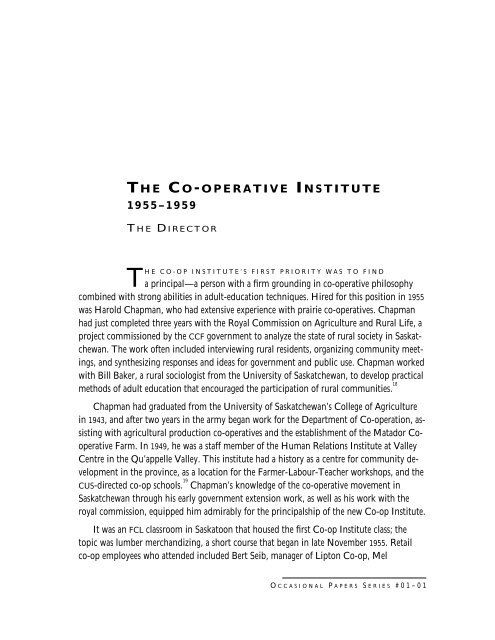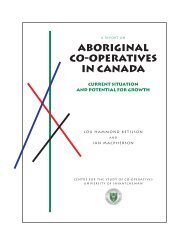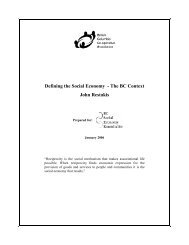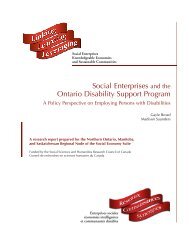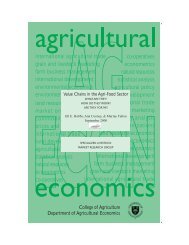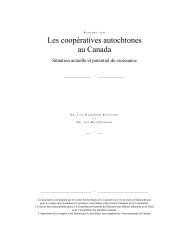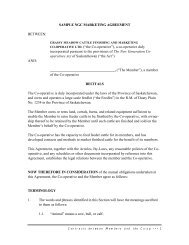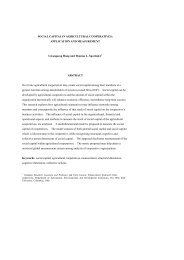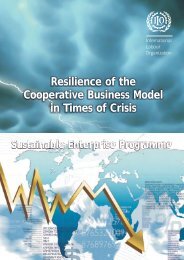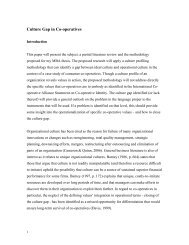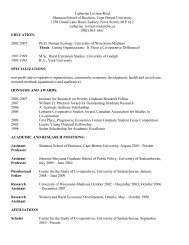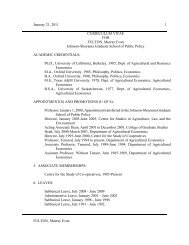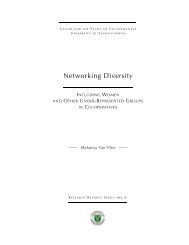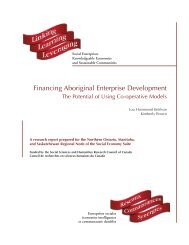Co-op College History - Centre for the Study of Co-operatives
Co-op College History - Centre for the Study of Co-operatives
Co-op College History - Centre for the Study of Co-operatives
You also want an ePaper? Increase the reach of your titles
YUMPU automatically turns print PDFs into web optimized ePapers that Google loves.
T HE C O-OPERATIVE I NSTITUTE<br />
1955–1959<br />
T HE D IRECTOR<br />
HE CO-OP INSTITUTE’S FIRST PRIORITY WAS TO FIND<br />
Ta principal—a person with a firm grounding in co-<strong>op</strong>erative philos<strong>op</strong>hy<br />
combined with strong abilities in adult-education techniques. Hired <strong>for</strong> this position in 1955<br />
was Harold Chapman, who had extensive experience with prairie co-<strong>op</strong>eratives. Chapman<br />
had just completed three years with <strong>the</strong> Royal <strong>Co</strong>mmission on Agriculture and Rural Life, a<br />
project commissioned by <strong>the</strong> CCF government to analyze <strong>the</strong> state <strong>of</strong> rural society in Saskatchewan.<br />
The work <strong>of</strong>ten included interviewing rural residents, organizing community meetings,<br />
and syn<strong>the</strong>sizing responses and ideas <strong>for</strong> government and public use. Chapman worked<br />
with Bill Baker, a rural sociologist from <strong>the</strong> University <strong>of</strong> Saskatchewan, to devel<strong>op</strong> practical<br />
methods <strong>of</strong> adult education that encouraged <strong>the</strong> participation <strong>of</strong> rural communities. 18<br />
Chapman had graduated from <strong>the</strong> University <strong>of</strong> Saskatchewan’s <strong>Co</strong>llege <strong>of</strong> Agriculture<br />
in 1943, and after two years in <strong>the</strong> army began work <strong>for</strong> <strong>the</strong> Department <strong>of</strong> <strong>Co</strong>-<strong>op</strong>eration, assisting<br />
with agricultural production co-<strong>op</strong>eratives and <strong>the</strong> establishment <strong>of</strong> <strong>the</strong> Matador <strong>Co</strong><strong>op</strong>erative<br />
Farm. In 1949, he was a staff member <strong>of</strong> <strong>the</strong> Human Relations Institute at Valley<br />
<strong>Centre</strong> in <strong>the</strong> Qu’appelle Valley. This institute had a history as a centre <strong>for</strong> community devel<strong>op</strong>ment<br />
in <strong>the</strong> province, as a location <strong>for</strong> <strong>the</strong> Farmer-Labour-Teacher worksh<strong>op</strong>s, and <strong>the</strong><br />
CUS-directed co-<strong>op</strong> schools. 19 Chapman’s knowledge <strong>of</strong> <strong>the</strong> co-<strong>op</strong>erative movement in<br />
Saskatchewan through his early government extension work, as well as his work with <strong>the</strong><br />
royal commission, equipped him admirably <strong>for</strong> <strong>the</strong> principalship <strong>of</strong> <strong>the</strong> new <strong>Co</strong>-<strong>op</strong> Institute.<br />
It was an FCL classroom in Saskatoon that housed <strong>the</strong> first <strong>Co</strong>-<strong>op</strong> Institute class; <strong>the</strong><br />
t<strong>op</strong>ic was lumber merchandizing, a short course that began in late November 1955. Retail<br />
co-<strong>op</strong> employees who attended included Bert Seib, manager <strong>of</strong> Lipton <strong>Co</strong>-<strong>op</strong>, Mel<br />
O CCASIONAL P APERS S ERIES #01–01


